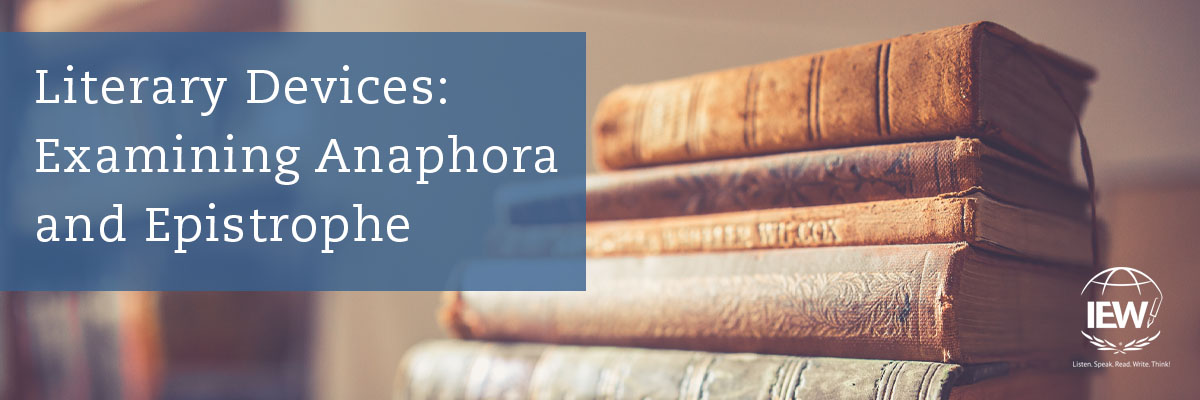Proficient writers are able to delve into a deep toolbox of literary devices to help them convey their ideas in an artistic and engaging manner. Prior blog posts have described a few of them, specifically simile and metaphor and consonance, alliteration, and assonance. In today’s post let’s take a look at two more: anaphora and epistrophe.
Think of anaphora and epistrophe as being a pair of bookends. These devices are used to emphasize ideas and are also referred to as rhetorical devices because they encourage readers to think. Anaphora and epistrophe both implement artistic use of repetition in sentences, clauses, or phrases; however, anaphora places the repetition at the beginning of the sentence, clause, or phrase, while epistrophe positions the repetition at the end of one. Both devices are incorporated into prose as well as poetry. Let’s look at some classic examples of the two.
Perhaps the most famous example of anaphora appears at the beginning of Charles Dickens’ novel A Tale of Two Cities. Here are the opening lines of the novel with the anaphora bolded:
It was the best of times, it was the worst of times, it was the age of wisdom, it was the age of foolishness, it was the epoch of belief, it was the epoch of incredulity, it was the season of Light, it was the season of Darkness, it was the spring of hope, it was the winter of despair, we had everything before us, we had nothing before us, we were all going direct to Heaven, we were all going direct the other way,—in short, the period was so far like the present period, that some of its noisiest authorities insisted on its being received, for good or for evil, in the superlative degree of comparison only.
Another excellent example of anaphora occurs in this poetic piece by Walt Whitman, called “When I Heard the Learn’d Astronomer.” This poem, by the way, is included in Level Three of Linguistic Development through Poetry Memorization.
“When I Heard the Learn’d Astronomer”
When I heard the learn’d astronomer;
When the proofs, the figures, were ranged in columns before me;
When I was shown the charts and the diagrams,
to add, divide, and measure them;
When I, sitting, heard the astronomer,
where he lectured with much applause in the lecture-room,
How soon, unaccountable, I became tired and sick;
Till rising and gliding out, I wander’d off by myself,
In the mystical moist night-air, and from time to time,
Look’d up in perfect silence at the stars.
Take a look at one more example, this one appearing in Dr. Martin Luther King’s famous oration, “I Have a Dream.” Here is a small portion of his seventeen-minute speech:
I have a dream that one day this nation will rise up and live out the true meaning of its creed: We hold these truths to be self-evident that all men are created equal.
I have a dream that one day on the red hills of Georgia, the sons of former slaves and the sons of former slave owners will be able to sit down together at the table of brotherhood.
I have a dream that one day even the state of Mississippi, a state sweltering with the heat of injustice, sweltering with the heat of oppression, will be transformed into an oasis of freedom and justice.
I have a dream that my four little children will one day live in a nation where they will not be judged by the color of their skin but by the content of their character. I have a dream today.
Let’s now turn our attention to epistrophe. As mentioned above, epistrophe also is a form of repetition, but it is utilized at the end of sentences, clauses, and phrases. Like anaphora, epistrophe emphasizes ideas. Perhaps the most famous example of this device appears in Abraham Lincoln’s “Gettysburg Address,” which is included in Level Five of Linguistic Development through Poetry Memorization. The final sentence underscores Lincoln’s point by his brilliant inclusion of epistrophe: “ … that this nation, under God, shall have a new birth of freedom—and that government of the people, by the people, and for the people, shall not perish from the earth.”
William Shakespeare’s Merchant of Venice exhibits another brief but rich example of epistrophe:
Portia:
If you had known the virtue of the ring,
Or half her worthiness that gave the ring,
Or your own honour to contain the ring,
You would not then have parted with the ring.
Anaphora and epistrophe add emphasis and elegance to an author’s writing. To discover further examples of these and other literary devices, check out Linguistic Development through Poetry Memorization. To access a sample of the curriculum, visit IEW.com/free-poetry.
|
Jennifer Mauser has always loved reading and writing and received a B.A. in English from the University of Kansas in 1991. Once she and her husband had children, they decided to homeschool, and she put all her training to use in the home. In addition to homeschooling her children, Jennifer teaches IEW classes out of her home, coaches budding writers via email, and tutors students who struggle with dyslexia. |


